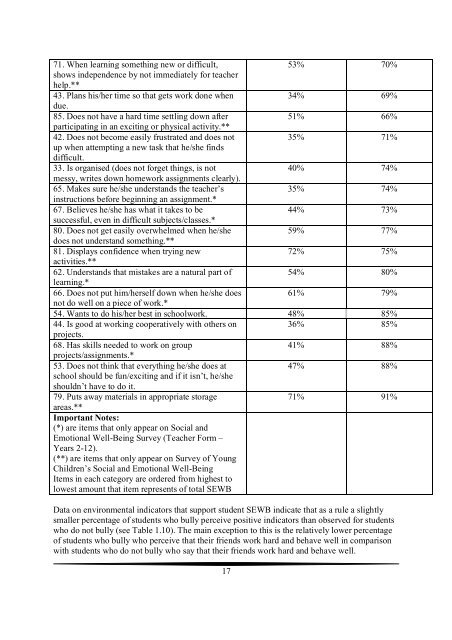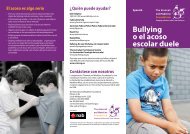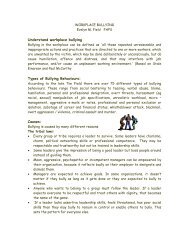The social and emotional wellbeing of students who bully different ...
The social and emotional wellbeing of students who bully different ...
The social and emotional wellbeing of students who bully different ...
Create successful ePaper yourself
Turn your PDF publications into a flip-book with our unique Google optimized e-Paper software.
71. When learning something new or difficult,53% 70%shows independence by not immediately for teacherhelp.**43. Plans his/her time so that gets work done when34% 69%due.85. Does not have a hard time settling down after51% 66%participating in an exciting or physical activity.**42. Does not become easily frustrated <strong>and</strong> does not35% 71%up when attempting a new task that he/she findsdifficult.33. Is organised (does not forget things, is not40% 74%messy, writes down homework assignments clearly).65. Makes sure he/she underst<strong>and</strong>s the teacher’s35% 74%instructions before beginning an assignment.*67. Believes he/she has what it takes to be44% 73%successful, even in difficult subjects/classes.*80. Does not get easily overwhelmed when he/she59% 77%does not underst<strong>and</strong> something.**81. Displays confidence when trying new72% 75%activities.**62. Underst<strong>and</strong>s that mistakes are a natural part <strong>of</strong>54% 80%learning.*66. Does not put him/herself down when he/she does61% 79%not do well on a piece <strong>of</strong> work.*54. Wants to do his/her best in schoolwork. 48% 85%44. Is good at working cooperatively with others on36% 85%projects.68. Has skills needed to work on group41% 88%projects/assignments.*53. Does not think that everything he/she does at47% 88%school should be fun/exciting <strong>and</strong> if it isn’t, he/sheshouldn’t have to do it.79. Puts away materials in appropriate storage71% 91%areas.**Important Notes:(*) are items that only appear on Social <strong>and</strong>Emotional Well-Being Survey (Teacher Form –Years 2-12).(**) are items that only appear on Survey <strong>of</strong> YoungChildren’s Social <strong>and</strong> Emotional Well-BeingItems in each category are ordered from highest tolowest amount that item represents <strong>of</strong> total SEWBData on environmental indicators that support student SEWB indicate that as a rule a slightlysmaller percentage <strong>of</strong> <strong>students</strong> <strong>who</strong> <strong>bully</strong> perceive positive indicators than observed for <strong>students</strong><strong>who</strong> do not <strong>bully</strong> (see Table 1.10). <strong>The</strong> main exception to this is the relatively lower percentage<strong>of</strong> <strong>students</strong> <strong>who</strong> <strong>bully</strong> <strong>who</strong> perceive that their friends work hard <strong>and</strong> behave well in comparisonwith <strong>students</strong> <strong>who</strong> do not <strong>bully</strong> <strong>who</strong> say that their friends work hard <strong>and</strong> behave well.17









